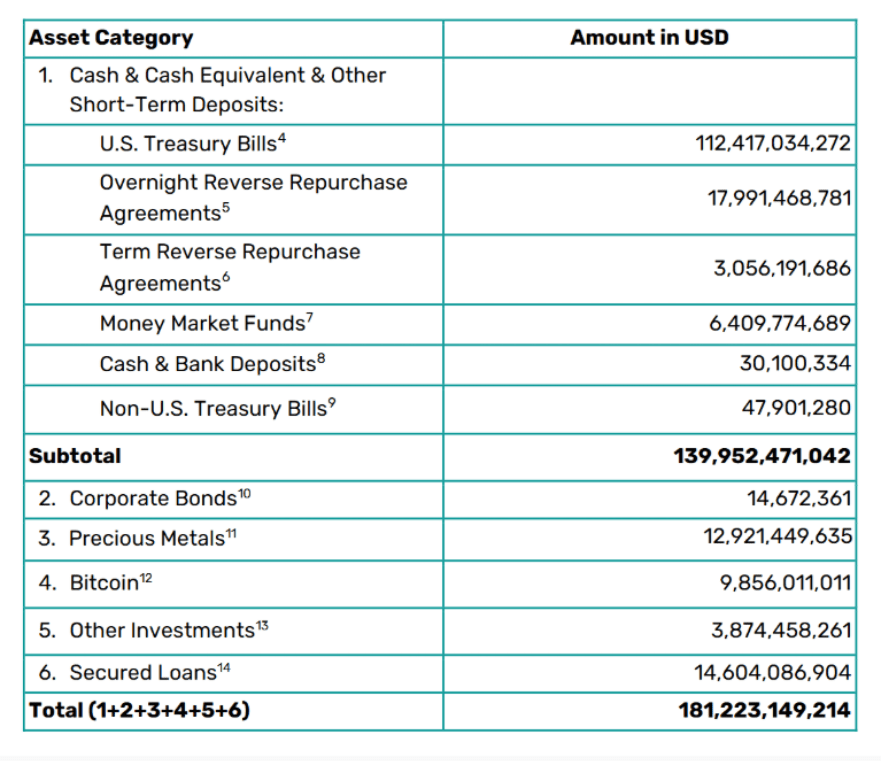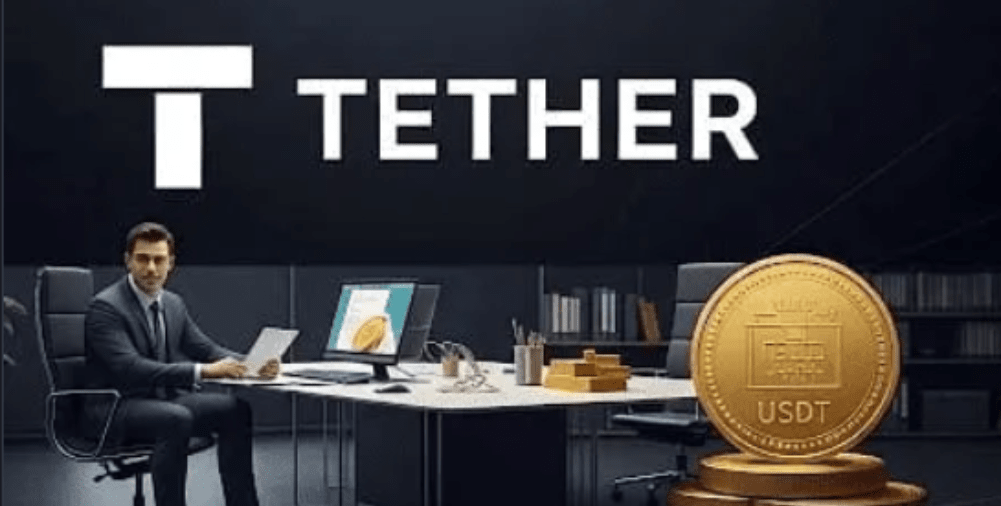Gold reserves of 12.9 billion USD, which surged by 7.6 billion in nine months, this stablecoin giant is stockpiling gold at a pace that surpasses sovereign countries, building an unprecedented 'borderless central bank' system.
The issuer of the world's largest stablecoin USDT, Tether, is stockpiling physical gold at an astonishing speed. According to the third quarter report of 2025, its gold reserves have soared from about 5.3 billion USD at the end of 2024 to 12.9 billion USD, with a net increase of over 7.6 billion USD in just nine months.
The speed of this stockpiling has even surpassed that of most central banks of sovereign countries.
Tether is no longer just a simple cryptocurrency company. By using U.S. bonds as a profit engine and gold and Bitcoin as value 'hardcore', it is building an unprecedented 'borderless central banking' system.
 1. Empire of Gold: Scale and Layout
1. Empire of Gold: Scale and Layout
Tether's gold strategy is not only reflected in its holdings but also in its penetration of the entire gold industry chain, from gold mining to trading, creating a complete ecosystem.
Gold reserves surpass those of nations
Tether's speed of gold accumulation is astonishing. Market analysis points out that Tether has added more than one ton of gold weekly over the past year, a pace that even surpasses that of most sovereign central banks.
● As of the third quarter of 2025, Tether's gold reserves had reached $12.9 billion, an increase of over 140% from about $5.3 billion at the end of 2024.
● This scale of gold holdings places Tether among the medium-sized gold-holding countries, with reserves exceeding the official reserves of countries such as Indonesia.
Full Industry Chain Layout
● In June 2025, Tether announced its acquisition of a strategic stake of up to 37.8% in the Canadian-listed mining rights company Elemental Altus Royalties Corp., retaining the right to increase its stake to 51.8%.
● This franchise model allows Tether to obtain stable gold production shares without bearing the risks of operating mines, ensuring the safety of its gold reserve supply from the source for decades to come.
● In addition to upstream gold mine resources, Tether has also 'poached' two of the world's top precious metals traders from HSBC, including HSBC's global metals trading head, Vincent Domien, who is also a current board member of the London Bullion Market Association (LBMA).
Gold tokenization products
● Tether has also launched the gold tokenization product Tether Gold (XAUT), with a market value exceeding $2.1 billion. This token is backed by physical gold, allowing users to hold and trade gold in a digital format.
● Tether has also partnered with Singapore financial services company Antalpha to raise at least $200 million for a project called 'Digital Asset Treasury' (DAT), aimed at establishing an 'institutional-grade gold-backed lending solution' for the XAUT token.
2. Business Model: 'U.S. Bonds-Gold' Closed Loop
Tether has constructed a seemingly perfect business model closed loop, making it one of the most efficient profit-making companies in the world.
Absorbing Global Dollar Funds
● By issuing the USDT stablecoin, Tether has absorbed nearly $180 billion in funds from the global market. This has provided it with a massive pool of funds, laying the foundation for subsequent investments.
Profit from U.S. Treasury Investments
● Tether will invest the vast majority of the funds it absorbs in highly liquid and secure U.S. Treasuries. As of the second quarter of 2025, its total exposure to U.S. Treasuries has reached $127 billion, making it one of the largest private holders of U.S. government debt globally.
● This debt scale makes it the seventh largest holder of U.S. Treasuries, surpassing countries and regions such as Canada and Taiwan.
● In the Federal Reserve's high interest rate cycle, Tether can easily earn billions of 'risk-free' interest from its U.S. Treasury holdings each year. In the second quarter of 2025 alone, Tether achieved a net profit of $4.9 billion.
Profits converted into gold
● Tether uses part of its profits to accumulate gold and lay out the gold industry to hedge against the depreciation of U.S. bonds or the risk of interest rate cuts. By accumulating gold and Bitcoin, Tether has achieved an excessive reserve ratio, further consolidating the safety and brand value of the stablecoin market, ultimately promoting the issuance of more stablecoins.
3. Financial Performance: Sources of Billions in Profits
Tether's financial performance in 2025 is remarkable, with a net profit exceeding $10 billion in the first nine months, pushing Tether's valuation to $500 billion, rivaling OPENAI.

Profit Structure Analysis
● Tether's profit sources are mainly composed of two parts: one is the stable interest income generated from its holdings of about $135 billion in U.S. Treasuries; the other comes from its holdings of gold and Bitcoin reserves, which have generated substantial unrealized profits during the bull market in 2025.
● Among them, the income that U.S. Treasuries may bring is about $4 billion (calculated at a 4% annual yield). The contribution from gold is particularly remarkable. At the beginning of 2025, the gold price was about $2,624 per ounce, and by September 30, the gold price had soared to $3,859, an increase of 47%.
● Based on Tether's $5.3 billion gold inventory at the end of 2024, just this portion of 'old gold' has generated approximately $2.5 billion in floating profits. Coupled with newly purchased gold in 2025, $3-4 billion of Tether's billions in profits come from gold appreciation.
Bitcoin Contribution
● The floating profits from BTC amount to about $2 billion. This diversified asset allocation enables Tether to maintain strong profitability in various market environments.
4. Cracks in the Perfect Empire
Behind the seemingly perfect business empire, Tether's vision of a 'borderless central bank' faces triple threats from regulation, the market, and competition.
Regulatory Wall
Gold reserves have brought Tether massive profits, but they have also become its biggest stumbling block on the road to compliance.
● In July 2025, the U.S. signed the (GENIUS Act), which explicitly requires that stablecoin issuers operating in the U.S. must have their reserves backed 100% by 'high-quality liquid assets', namely cash in U.S. dollars or short-term U.S. Treasuries.
● According to Tether's Q3 report, its total reserves reached $181.2 billion, with issued USDT at $174.4 billion. Among these, $12.9 billion in gold and $9.9 billion in Bitcoin are all considered 'non-compliant assets' under the (GENIUS Act) definition.
● This scene has already played out in Europe. Due to Tether's reserves not complying with the EU's MiCA regulations, from the end of 2024 to March 2025, almost all mainstream exchanges, including Coinbase, have delisted USDT in the European Economic Area (EEA).
● As the details of the (GENIUS Act) are gradually implemented in the next 18 months, all U.S. compliant exchanges will be forced to make the same choice. Tether's response also confirms the reality of this threat. In September 2025, Tether announced the establishment of Tether America and plans to launch a new stablecoin named USAT in December. This USAT will be 100% compliant (only holding Treasuries), specifically for the U.S. market.
Market Risks
● Tether's profit structure also carries significant risks. If market conditions change in 2026, Tether's profit growth could slow or even turn into losses. Multiple mainstream financial institutions predict that the Federal Reserve will enter a rate-cutting cycle in 2026. According to estimates, if the Fed cuts rates by 25 basis points, Tether's annual revenue will decrease by $325 million.
● On the other hand, the gold and Bitcoin markets experienced a frenzied bull market in 2025. Once these two assets enter a bear market cycle, Tether's profits will also shrink significantly.
Competitive Threats
● The tightening of regulations is reshaping the market landscape for stablecoins. The biggest beneficiary is Circle's USDC. As a compliance leader, USDC has been well-received by regulators.
● Circle's Q3 2025 financial report shows that its USDC circulation reached $73.7 billion at the end of the quarter, achieving a year-on-year growth of 108%.
● In contrast, although Tether remains dominant, its growth has shown signs of fatigue. Based on the current growth rate of stablecoin issuance, USDC is expected to surpass USDT around 2030.
5. Strategic Choices at the Crossroads
Facing multiple challenges, Tether stands at a crossroads of strategic choices. Its future development direction may depend on the following factors:
Regulatory Adaptability
● Tether has begun to address regulatory challenges, including the establishment of Tether America, which is responsible for U.S. compliance operations, and the launch of the USAT stablecoin, which is 100% backed by U.S. Treasuries.
● This 'dual-track parallel' strategy—protecting the global USDT's gold and Bitcoin reserve strategy on one hand, and advancing into the U.S. compliant market through USAT on the other—may be Tether's main direction of development in the future.
Asset Allocation Optimization
● Despite facing regulatory pressure, Tether has not abandoned its gold strategy. On the contrary, it continues to expand both Bitcoin and gold assets in parallel. Most of the company's reserves remain in liquid instruments such as U.S. Treasuries, ensuring strong liquidity while increasing protection through hard assets.
Market Prospects
● According to institutions like JPMorgan and Goldman Sachs, the Fed's rate-cutting cycle in 2026 will not only fail to trigger a bear market but will also become the 'fuel' that drives gold and Bitcoin prices to new highs. If the market develops according to this scenario, Tether's 'gold strategy' will help it reach new heights.
 Tether's 'U.S. Bonds-Gold' closed-loop model is both a challenge to the traditional financial system and a reshaping of the future of decentralized finance. Its gold reserves contributed $3-4 billion in floating profits during the first three quarters of 2025, becoming a key pillar of its billions in profits. With a high regulatory wall, Tether has begun to set up defenses—establishing Tether America and preparing to launch a fully compliant USAT stablecoin. Whether this dual-track path can successfully navigate the narrow channels of compliance and innovation will determine how far this 'borderless central bank' can go.
Tether's 'U.S. Bonds-Gold' closed-loop model is both a challenge to the traditional financial system and a reshaping of the future of decentralized finance. Its gold reserves contributed $3-4 billion in floating profits during the first three quarters of 2025, becoming a key pillar of its billions in profits. With a high regulatory wall, Tether has begun to set up defenses—establishing Tether America and preparing to launch a fully compliant USAT stablecoin. Whether this dual-track path can successfully navigate the narrow channels of compliance and innovation will determine how far this 'borderless central bank' can go.
Join our community to discuss and become stronger together!
Official Telegram community: https://t.me/aicoincn
AiCoin Chinese Twitter: https://x.com/AiCoinzh
OKX benefit group: https://aicoin.com/link/chat?cid=l61eM4owQ
Binance benefit group: https://aicoin.com/link/chat?cid=ynr7d1P6Z


